The rotator cuff is a specialized, small group of tendons and muscles that help anchor and stabilize the shoulder joint. These four muscles ensure the smooth, pain-free movement of the shoulder – and when they’re seriously injured, surgical intervention is sometimes required.While most rotator cuff injuries do not require surgery, some do – such as serious rotator cuff tears caused by trauma to the shoulder, or repetitive motion (swimming, bowling, bench pressing, etc.)
If you’re going to get rotator cuff surgery, you’ll want to understand how long it takes for the shoulder to heal – and when you can expect to get back to your normal day-to-day life.

0-6 Weeks – Keep The Arm Immobile While It Heals
The shoulder and the rotator cuff are extremely delicate, particularly immediately after surgery. You will be encouraged by your surgeon to keep the shoulder as immobile as possible. Usually, a sling will be recommended, and it should not be removed for several weeks after the surgery. The sling helps keep weight off of your tendons and muscles, aiding the recovery process and protecting the surgery.
It also prevents you from accidentally damaging your shoulder – for example, if you begin to trip and fall, the instinctual reaction would be to grab a banister or railing with your damaged shoulder, which could result in serious damage. Some patients have even re-injured them during sleep.
After several weeks, your surgeon will recommend basic physical therapy, or “passive movement.” Passive movement involves no contraction of the bicep. The therapist will move your arm for you, without straining the joint, in order to prevent the formation of scar tissue that could impinge joint movement.
6-12 Weeks – Limited, Supervised Arm Movements
Usually, your sling can be removed after about six weeks, though this may vary in some cases. Even after the sling has been removed, you must avoid putting undue strain on the shoulder – do not lift, push, or pull heavy objects, and perform only the arm movements recommended by your physical therapist.
Your physical therapist will likely begin allowing you to perform movements that involve muscle contraction in a supervised environment.
3-6 Months – Strengthening The Arm With Physical Therapy
At this time, the shoulder has recovered from surgery, and you are no longer at risk of damaging your sutures when flexing the muscles and tendons in the shoulder. Still, the tendon-to-bone attachment may be healing, so excess strain should not be placed on the joint.
Your therapist will recommend a number of lightweight, exercises that should be used to strengthen the muscles in your arm and shoulder, which have likely become weakened during the recovery process.
You should still be avoiding shocks and strains to your shoulder, as well as the lifting, pushing, or pulling of heavy objects. Follow all of your surgeon and physical therapist’s instructions.
6+ Months – Full Recovery (And Avoiding Re-Injury)
Full recovery usually takes somewhere between 6 months to a year, depending on the age, health, and other conditions of the patient. At this time, your shoulder should be functioning normally, and you will be able to do most of the things you did before your injury.
However, your doctor or physical therapist may recommend a change in your routine, or how you perform exercises, to ensure that you do not re-injure your arm. If you sustained an injury while golfing, for example, you may no longer be able to golf, or you might need to change your stroke to avoid further damage to the muscle and joint. Ask your therapist for more information about this.
Recovering From Rotator Cuff Surgery Requires Time, Patience, And Commitment
So, what to expect after rotator cuff surgery is a full recovery, although it will take a long time. The shoulder is delicate and takes quite a bit of patience to ensure that you do not re-injure yourself while healing. But if you understand the time required – and follow all instructions from your physicians and physical therapists – you’re sure to make a full recovery.